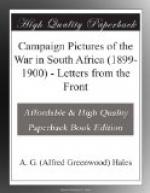When we left Thaba Nchu, General French left us, as did also Hamilton and Smith-Dorien. Brabant hugged the Basuto border, and swept the land clean of everything hostile. General Rundle (the flower of courtesy and chivalry) kept the centre; General Boyes looked after our left wing; General Campbell picked up the intermediate spaces as occasion demanded; and so we moved on, trying, but trying in vain, to draw a cordon round the ever-shifting foe. There was no chance for a dashing forward move; the country through which we passed was lined by kopjes, which were simply appalling in their native strength. What prompted the Boer leaders to fall back from them, step by step, will for ever remain a mystery to me. It was not want of provisions, for we knew that they had huge supplies of beef and mutton, whilst there were in their possession almost inexhaustible stores of grain. It was not want of fodder for their horses, for the valleys and veldt were covered with beautiful grass, almost knee-deep. Water was plentiful in all directions, and they apparently possessed plenty of ammunition. Prisoners assert that Commandant Olivier was absolutely furious when compelled to fall back, by order of his superiors. It is also asserted that he is now in dire disgrace on account of his refusal to obey promptly some of his superior’s commands. It is further stated that he is to be deposed from his command, and will cease to be a factor of any importance in the war. It is hard to fathom Boer tactics. It does not follow because a line of kopjes are abandoned to-day that the burghers have retreated; they fall back before scouting parties; their pickets watch our scouts return to camp, knowing that they will convey the news to headquarters that the kopjes are empty of armed men. Then, with almost incredible swiftness, the light-armed Boers swarm back by passes known only to themselves, and secretly and silently take up positions where they can butcher an advancing army. If General Rundle had been a rash, impetuous, or a headstrong man, he could comfortably have lost his whole force on half a dozen occasions; but he is not. He is essentially a cautious leader, and pits his brain against that of the Boer leaders as a good chess player pits his against an opponent. He may believe in the luck of the British Army, but he trusts mighty little to it. Better lose a couple of days than a couple of regiments is his motto, and a wise motto it is. Had he flung his men haphazard at any of the positions where the Boers have made a stand, he would have been cut to pieces.
Rundle plays a wise game. When the enemy looks like sitting tight, Rundle at once commences a series of manoeuvres directed from his centre. This keeps the enemy busy, and gives them a lot of solid thinking to do, and whilst they are thinking he moves his flanks forward, overlapping them in the hope of surrounding them. The Boer hates to have his rear threatened, and invariably falls away. His method




